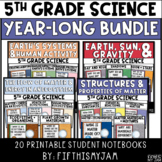Matter and Energy in an Ecosystem | All Digital Learning
- Zip
- Google Apps™

What educators are saying
Also included in
- What does an ecosystem include, what is an aquatic biome and a terrestrial biome, and how do human activities affect ecosystems? While the standards closely align with 5th Grade NGSS standards, if you are teaching about ecosystems and organisms in general, this may be perfect for you! Here your studPrice $24.78Original Price $35.40Save $10.62
- ➡ PLEASE READ BEFORE PURCHASING ⬅By purchasing the bundle, you receive all units/notebook sets within this bundle at a 30% discount. As additional resources are added, the bundle's price will increase accordingly. By purchasing the bundle at the current price, you will receive future resources addedPrice $89.99Original Price $170.95Save $80.96
- ➡ PLEASE READ BEFORE PURCHASING ⬅⭐ By purchasing this bundle, you receive all notebooks within this set at a 30% discount. The bundle price will increase accordingly as additional resources and sets are added. By purchasing the bundle at the current price, you will receive future resources added toPrice $49.99Original Price $79.00Save $29.01
Description
What does an ecosystem include, what is an aquatic biome and a terrestrial biome, and how do human activities affect ecosystems? While the standards closely align with 5th Grade NGSS standards, if you teach about ecosystems and organisms in general, this may be perfect for you!
Included in this bundle:
- 5 DIGITAL (NOT PRINTABLE) guided notebook lessons with reading passages included (for use in Google Slides)
- This entire set includes full guided student notes for teaching:
- What an ecosystem is.
- The two types of ecosystems and the organisms that live within each (producers, consumers, and decomposers).
- The role plants play in an ecosystem.
- The five essential materials a plant needs for growth.
- A closer look at those essential parts (roots/stems/leaves and nutrients and minerals).
- Food chains and food webs.
- The organisms that comprise each trophic level.
- The conditions that make an ecosystem healthy and those that can affect an ecosystem drive it to become unhealthy.
- How humans impact ecosystems, both positively and negatively.
- Six investigations for both hands-on experience and research experience.
- 7 KLEW charts to be digitally displayed (Whiteboard, Google Slides, or Jamboard).
- Study guides and assessments included (partially graded. All short answer and constructed response paragraphs must be manually graded unless you eliminate them).
- Outlined Scope and Sequence for all five lessons.
- START HERE guide with additional tips to support using this product.
Look for the START HERE guide first when opening this zipped file. There is a separate file with the digital links (Google Slides). Additionally, you can assign your students a digital partially self-grading assessment (Google Forms), as well as the same with a digital partially self-grading study guide. In the guide, you will see tips and tricks for what you can do with each file. You will need to make a copy and save it in Google Drive, and you can assign using Google Classroom (perfect for students who may be absent).
**Must have access to a Google Drive account to make a copy of each document and save it.
➡ Jamboard™ is an interactive digital whiteboard developed in the G-Suite of tools. They are easy to use while teaching live via Google Meet or Zoom once you share your screen with students, and you can share the Jamboard™ and Google Slide links with your students using either Google Classroom or the Zoom chatbox. Students do not need a Google email to open a Jamboard™ link. Directions for how to share are found within the download. *BEFORE PURCHASING, PLEASE CHECK WITH YOUR DISTRICT TO MAKE SURE JAMBOARD IS NOT BLOCKED* If so, it never hurts to ask the Tech department if they could unblock. However, if impossible, having Google Slides will be beneficial.
**PLEASE email me (fifthismyjam@gmail.com) if you have any questions or need support.
Next Generation Science Standards Addressed:
5-PS1-1
5-PS3-1
5-LS1-1
5-LS2-1
5-ESS3-1
You can find other DIGITAL SCIENCE companion resources here:
➡ Structures and Properties of Matter | All Digital Learning
➡ Earth's Systems and Human Activity | All Digital Learning
➡ Earth Sun and Gravity | All Digital Learning
Don't forget that leaving feedback earns you points toward FREE TPT purchases. I love that feedback!
Also, FOLLOW ME and be notified when new products are uploaded. New products are always 50% off for the first 48 hours after they are posted. It pays to follow me!
Additionally, SUBSCRIBE to my email list to get biweekly freebies and tips and tricks for the upper elementary classroom!
Please feel free to contact me with any questions!
Thank you kindly,
Rachel Jamison








